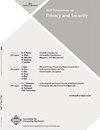A Solicitous Approach to Smart Contract Verification
IF 2.8
4区 计算机科学
Q2 COMPUTER SCIENCE, INFORMATION SYSTEMS
引用次数: 0
Abstract
Smart contracts are tempting targets of attacks, as they often hold and manipulate significant financial assets, are immutable after deployment, and have publicly available source code, with assets estimated in the order of millions of dollars being lost in the past due to vulnerabilities. Formal verification is thus a necessity, but smart contracts challenge the existing highly efficient techniques routinely applied in the symbolic verification of software, due to specificities not present in general programming languages. A common feature of existing works in this area is the attempt to reuse off-the-shelf verification tools designed for general programming languages. This reuse can lead to inefficiency and potentially unsound results, as domain translation is required. In this article, we describe a carefully crafted approach that directly models the central aspects of smart contracts natively, going from the contract to its logical representation without intermediary steps. We use the expressive and highly automatable logic of constrained Horn clauses for modeling and instantiate our approach to the Solidity language. A tool implementing our approach, called Solicitous, was developed and integrated into the SMTChecker module of the Solidity compiler solc. We evaluated our approach on an extensive benchmark set containing 22,446 real-world smart contracts deployed on the Ethereum blockchain over a 27-month period. The results show that our approach is able to establish safety of significantly more contracts than comparable, publicly available verification tools, with an order of magnitude increase in the percentage of formally verified contracts.智能合约验证的一种吸引人的方法
智能合约是诱人的攻击目标,因为它们通常持有和操纵重要的金融资产,部署后不可变,并且具有公开可用的源代码,过去由于漏洞估计损失了数百万美元的资产。因此,形式验证是必要的,但由于一般编程语言中不存在的特殊性,智能合约挑战了常规应用于软件符号验证的现有高效技术。该领域现有工作的一个共同特征是尝试重用为通用编程语言设计的现成验证工具。由于需要进行域转换,这种重用可能导致效率低下和潜在的不可靠结果。在本文中,我们描述了一种精心设计的方法,该方法直接对智能合约的核心方面进行本地建模,从合约到其逻辑表示,无需中间步骤。我们使用富有表现力和高度自动化的约束Horn子句逻辑进行建模,并实例化我们对solid语言的方法。我们开发了一个实现我们方法的工具,名为Solicitous,它被集成到Solidity编译器solc的SMTChecker模块中。我们在一个广泛的基准集上评估了我们的方法,该基准集包含了在27个月的时间里部署在以太坊区块链上的22,446个真实世界的智能合约。结果表明,我们的方法能够比可比的、公开可用的验证工具建立更多合同的安全性,并且在正式验证的合同的百分比上增加了一个数量级。
本文章由计算机程序翻译,如有差异,请以英文原文为准。
求助全文
约1分钟内获得全文
求助全文
来源期刊

ACM Transactions on Privacy and Security
Computer Science-General Computer Science
CiteScore
5.20
自引率
0.00%
发文量
52
期刊介绍:
ACM Transactions on Privacy and Security (TOPS) (formerly known as TISSEC) publishes high-quality research results in the fields of information and system security and privacy. Studies addressing all aspects of these fields are welcomed, ranging from technologies, to systems and applications, to the crafting of policies.
 求助内容:
求助内容: 应助结果提醒方式:
应助结果提醒方式:


